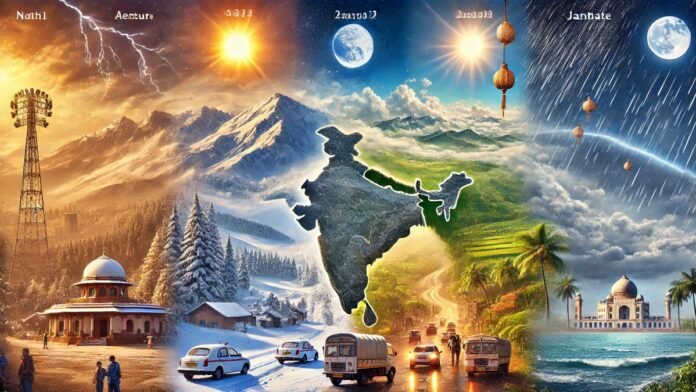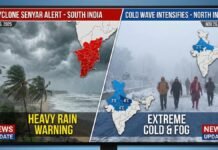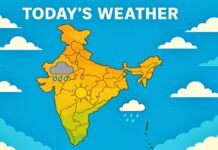
Key Points:
- Delhi-NCR experiencing continuous heavy rainfall since Monday due to western disturbance; orange alert issued for next 36 hours
- Maximum temperature in Delhi drops to 26.5°C (7.7 degrees below normal) with minimum at 20.6°C
- Heavy rain warning issued for Punjab, Haryana, Chandigarh, Bihar, West Bengal, Jharkhand, and Odisha over next 24 hours
- Waterlogging and traffic disruptions expected across Delhi-NCR following Tuesday morning downpour
- Fresh Himalayan snowfall predicted to further lower temperatures in northern plains
- Monsoon return brings rainfall to eastern and western Uttar Pradesh with winds gusting up to 40 km/h
- Northeast and South India forecast to receive intermittent rainfall for next 5 days
New Delhi: Delhi-NCR has been lashed by persistent heavy rainfall since Monday morning, with intermittent showers continuing for the third consecutive day as a powerful western disturbance sweeps across North India. The India Meteorological Department (IMD) has issued an orange alert for the National Capital Region for the next 36 hours, warning residents to brace for waterlogging, traffic congestion, and challenging commuting conditions following intense rainfall that began early Tuesday morning.
Temperature Plunge in Delhi
The capital city witnessed a significant temperature drop on Monday as overcast conditions persisted throughout the day. The maximum temperature plummeted to 26.5 degrees Celsius, approximately 7.7 degrees below the normal seasonal average, creating unseasonably cool conditions for early October. The minimum temperature was recorded at 20.6 degrees Celsius, sitting 1.7 degrees below normal levels.
Meteorological experts attribute this sharp temperature decline to the combined effect of the active western disturbance and extensive cloud cover that has blocked solar radiation. The department has warned that temperatures are expected to drop further in coming days as fresh snowfall blankets the Himalayan regions, sending cold air masses toward the northern plains.
Western Disturbance Impact
The current spell of widespread rainfall across Delhi-NCR stems from a robust western disturbance—a weather system originating from the Mediterranean region that brings moisture-laden winds to the Indian subcontinent. These disturbances are particularly common during winter months but can occur during transitional seasons, bringing unseasonal rainfall and temperature fluctuations.
The meteorological department has extended heavy rainfall warnings to Punjab, Haryana, and Chandigarh over the next 24 hours, indicating the western disturbance’s extensive spatial coverage. Thunderstorms accompanying the rainfall pose additional risks, including lightning strikes and localized gusty winds that could damage vulnerable structures and disrupt power supply.
Waterlogging and Traffic Concerns
Following the heavy downpour that commenced early Tuesday morning, Delhi-NCR authorities are preparing for significant waterlogging in low-lying areas and neighborhoods with inadequate drainage infrastructure. Past rainfall events have exposed vulnerabilities in the capital’s drainage systems, with areas like Minto Road, ITO, Pragati Maidan tunnel, and various underpasses becoming notorious bottlenecks during monsoon weather.
Traffic disruptions are anticipated across major arterial roads and highways connecting Delhi with neighboring Noida, Gurgaon, Ghaziabad, and Faridabad. Commuters have been advised to plan additional travel time, monitor real-time traffic updates, and consider alternate routes where possible. Municipal authorities have deployed pumping stations and emergency response teams to address waterlogging complaints promptly.
Uttar Pradesh Weather Forecast
The monsoon’s unexpected return to Uttar Pradesh has transformed weather conditions across the state, with dense, dark clouds blanketing numerous districts on Tuesday, October 7. The IMD forecasts rain and thundershowers across both eastern and western regions of India’s most populous state, accompanied by strong winds that could reach speeds of 40 kilometers per hour.
The extensive list of affected districts includes Varanasi, Sonbhadra, Mirzapur, Chandauli, Ghazipur, Jaunpur, Sitapur, Ambedkar Nagar, Basti, Ayodhya, Gonda, Balrampur, Shravasti, Bahraich, Barabanki, Lakhimpur Kheri, Hardoi, Kannauj, Auraiya, Badaun, Bareilly, Rampur, Sambhal, Moradabad, and Bijnor. Light to moderate rainfall accompanied by thunder and lightning is predicted for these areas, potentially affecting agricultural operations and daily activities.
Bihar Agricultural Alert
Bihar faces continued thunderstorm and rainfall activity over the next 2-3 days, with particularly heavy precipitation expected in northeastern regions of the state. This weather pattern poses significant challenges for the agricultural sector during the crucial harvest season.
The state Agriculture Department has issued urgent advisories to farmers, recommending immediate drainage of excess water from agricultural fields to prevent crop damage. Standing water can cause root rot, fungal diseases, and complete crop failure, particularly for vegetables and pulse crops. Farmers have been instructed to implement protective measures including field drainage, crop harvesting where mature, and storage of harvested produce in dry locations.
Uttarakhand Mountain Weather
The Meteorological Department has issued specific warnings for Uttarakhand’s mountainous districts, including Chamoli, Bageshwar, Pauri Garhwal, Nainital, and Almora. The combination of heavy rainfall and strong winds creates heightened risks of landslides, rockfalls, and road blockages in these geologically sensitive areas.
The state administration has appealed to residents and tourists to avoid unnecessary travel, particularly on vulnerable mountain roads prone to landslides. Pilgrimage routes and popular tourist destinations in the Kumaon and Garhwal regions may experience temporary closures if conditions deteriorate. Disaster management teams have been placed on high alert to respond to emergency situations.
Eastern India Weather Pattern
Heavy rainfall accompanied by thunderstorms is predicted to continue across Bihar, West Bengal, Jharkhand, and Odisha over the coming 24 hours. This weather system brings relief from pre-winter heat but also poses flood risks in low-lying areas, particularly in West Bengal’s coastal districts and Odisha’s river basins.
Local authorities in these states have activated flood monitoring systems and early warning mechanisms to protect vulnerable populations. Disaster management teams are conducting preparedness drills and positioning relief materials in flood-prone areas to enable rapid response if situations escalate.
Northeast India Extended Forecast
The northeastern states of Arunachal Pradesh, Assam, Meghalaya, Nagaland, Manipur, Mizoram, and Tripura are expected to experience intermittent rainfall for the next five days. This prolonged wet spell aligns with the region’s characteristic weather patterns but may cause disruptions to transportation, agriculture, and daily life.
The region’s hilly terrain makes it particularly susceptible to landslides during extended rainfall periods. Road connectivity between states and remote areas often suffers during such weather events, potentially isolating communities and disrupting supply chains. State governments have been advised to maintain emergency supplies and communication systems.
South India Weather Developments
Southern India is bracing for significant rainfall activity, with Tamil Nadu, Kerala, Karnataka, and Andhra Pradesh expected to receive heavy precipitation until October 10. This rainfall pattern is attributed to atmospheric circulation changes and moisture incursion from the Bay of Bengal.
Coastal areas face additional concerns from strong winds and high waves, prompting the IMD to issue advisories for fishermen. The department has strongly recommended that fishing communities avoid venturing into deep waters until weather conditions stabilize. Coastal villages have been alerted about potential sea surges and advised to maintain vigilance.
Agricultural Implications
The widespread rainfall across multiple states presents both opportunities and challenges for India’s agricultural sector. While the moisture replenishes soil moisture levels and benefits late-season crops, excessive rainfall during harvest periods can damage standing crops, reduce grain quality, and complicate harvesting operations.
Farmers growing kharif crops approaching harvest maturity face particular challenges, as wet conditions can cause lodging (crops falling over), grain germination while still on plants, and increased susceptibility to fungal diseases. The Agriculture Department’s advisories emphasize immediate protective actions to minimize crop losses.
Public Safety Recommendations
Authorities across affected states have issued comprehensive safety guidelines for residents. Key recommendations include avoiding travel during heavy rainfall periods, staying away from waterlogged areas that may conceal open drains or potholes, remaining indoors during thunderstorms, and avoiding contact with electrical equipment if flooding occurs.
Parents have been advised to ensure children’s safety during school commutes, with some schools potentially declaring holidays if conditions become severe. Office-goers are encouraged to work from home where possible to reduce traffic congestion and exposure to hazardous conditions.
Long-Term Weather Outlook
The persistence of this western disturbance combined with fresh Himalayan snowfall suggests that North India may experience an extended period of cooler temperatures and intermittent rainfall. This weather pattern, unusual for early October, could signal an early onset of winter-like conditions in northern regions.
Meteorologists continue monitoring atmospheric developments, including the possibility of additional western disturbances forming over the coming weeks. Residents across affected regions should remain updated through official weather bulletins and prepare for variable conditions as the transition from post-monsoon to winter season progresses.
The current weather event underscores India’s climatic diversity and the importance of robust forecasting systems in minimizing disruption to daily life and economic activities across this vast and geographically varied nation.




















































